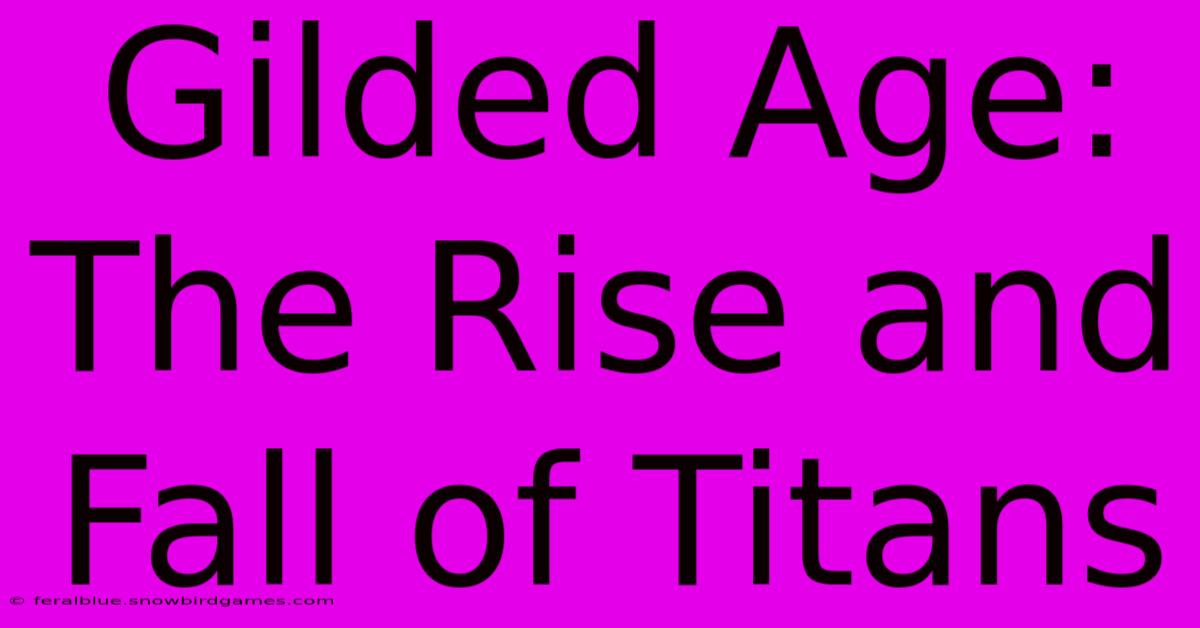Gilded Age: The Rise And Fall Of Titans

Table of Contents
Gilded Age: The Rise and Fall of Titans
The Gilded Age. A period shimmering with opulent wealth and dazzling innovation, yet tarnished by stark inequality and ruthless industrial practices. This era, roughly spanning from the 1870s to the 1890s, witnessed the meteoric rise of titans of industry who shaped the modern American landscape, leaving behind a legacy both celebrated and condemned. Understanding this complex period requires examining both the spectacular successes and the devastating failures that defined it.
The Rise of Industrial Titans: Forging Fortunes in Steel, Oil, and Railroads
The Gilded Age was fueled by unprecedented industrial growth. Robber barons, as they were often called, amassed colossal fortunes through shrewd business practices, relentless innovation, and sometimes, questionable ethics.
Andrew Carnegie: The Steel King
Andrew Carnegie's story is the quintessential Gilded Age narrative. Starting as a penniless immigrant, he climbed the ladder of success in the burgeoning steel industry. His mastery of vertical integration – controlling every stage of production, from raw materials to finished product – allowed him to dominate the market and amass a fortune estimated at nearly $300 billion in today's money. Carnegie's philanthropy, however, softened the image of the ruthless industrialist, leaving behind a legacy of libraries and educational institutions.
John D. Rockefeller: The Oil Monopoly
John D. Rockefeller, the founder of Standard Oil, epitomized the power of monopolies. Through ruthless competition and strategic acquisitions, he virtually controlled the American oil industry. His innovative business practices, including horizontal integration (controlling all aspects of a single stage of production), were both admired and feared. While his wealth was astronomical, his business tactics were often accused of being monopolistic and anti-competitive.
Cornelius Vanderbilt: Railroad Empire
Cornelius Vanderbilt, already a wealthy steamboat magnate, amassed an even greater fortune through his shrewd investments and consolidation of railroad lines. He created a vast and efficient railway network, revolutionizing transportation and significantly impacting the growth of the American economy. However, his aggressive business practices and exploitation of labor often drew criticism.
The Dark Side of the Gilded Age: Inequality and Social Unrest
While the titans amassed unimaginable wealth, the vast majority of Americans struggled with poverty and inequality. The gap between the rich and the poor widened dramatically, fueling social unrest and labor movements.
The Rise of Labor Unions: Fighting for Workers' Rights
The harsh conditions faced by factory workers, including long hours, low wages, and dangerous working environments, sparked the growth of powerful labor unions. Organizations like the Knights of Labor and the American Federation of Labor fought for better working conditions, fair wages, and the right to organize. Significant strikes, like the Pullman Strike of 1894, highlighted the growing tension between labor and capital.
The Rise of Populism: A Challenge to the Establishment
The growing inequality and the perceived corruption of big business and politics fueled the rise of populism. Populist movements demanded reforms aimed at curbing the power of corporations and protecting the interests of ordinary farmers and workers. Figures like William Jennings Bryan became prominent voices advocating for greater economic equality and government regulation.
The Fall of Titans and the Legacy of the Gilded Age
The Gilded Age eventually gave way to a new era of reform and regulation. Antitrust laws were passed to curb the power of monopolies, and labor movements gained some ground. The excesses of the era prompted a reevaluation of the relationship between wealth, power, and social responsibility.
While the Gilded Age is often associated with robber barons and unchecked capitalism, its legacy is far more nuanced. This era laid the foundation for modern American industry, infrastructure, and finance. However, it also highlighted the inherent inequalities of unchecked capitalism and the vital need for social reform. Understanding the rise and fall of the Gilded Age's titans offers crucial insights into the complexities of American history and the enduring tension between wealth creation and social justice.

Thank you for visiting our website wich cover about Gilded Age: The Rise And Fall Of Titans. We hope the information provided has been useful to you. Feel free to contact us if you have any questions or need further assistance. See you next time and dont miss to bookmark.
Featured Posts
-
Mavy Legaspis Age A Deeper Dive
Apr 02, 2025
-
Unlocking The Potential Of Fungi Exploring Their Traits
Apr 02, 2025
-
Max Verstappens Net Worth A Legacy Of Excellence
Apr 02, 2025
-
Ruth Elliss Daughter A Life Less Ordinary
Apr 02, 2025
-
Bmi Calculator Kg Age Your Health Journey Starts Here
Apr 02, 2025
